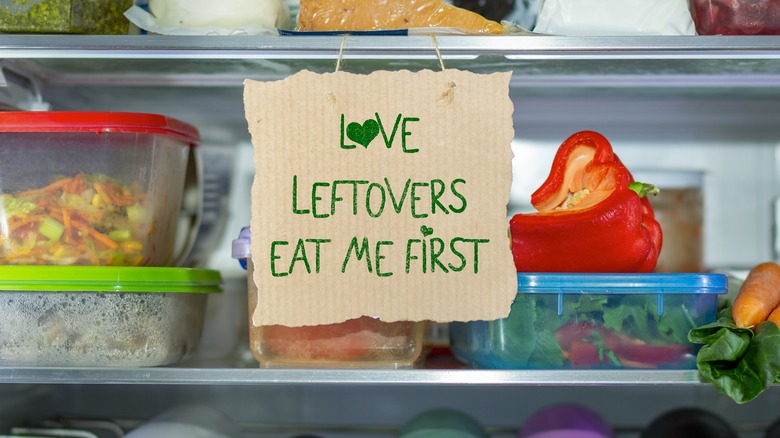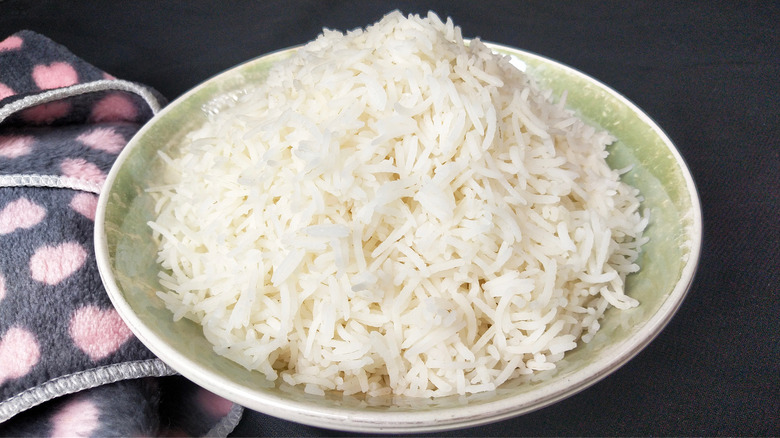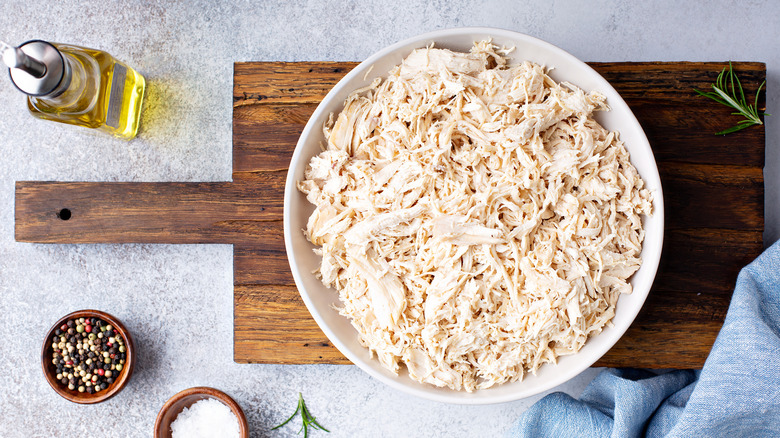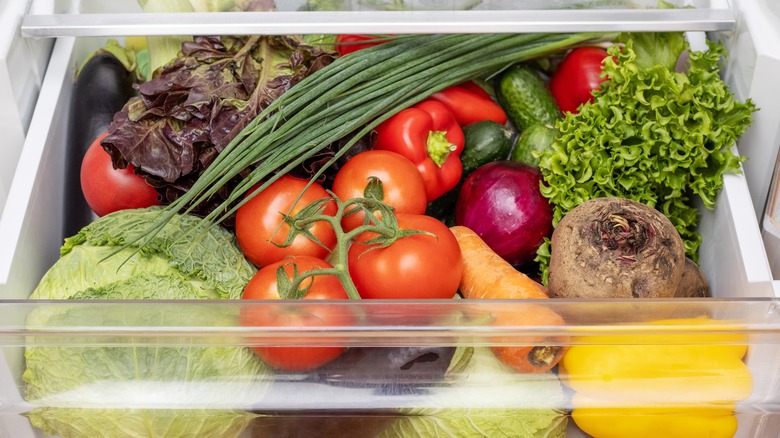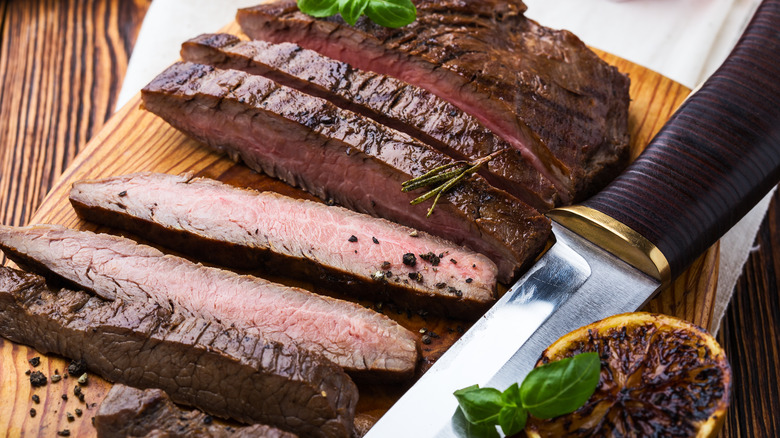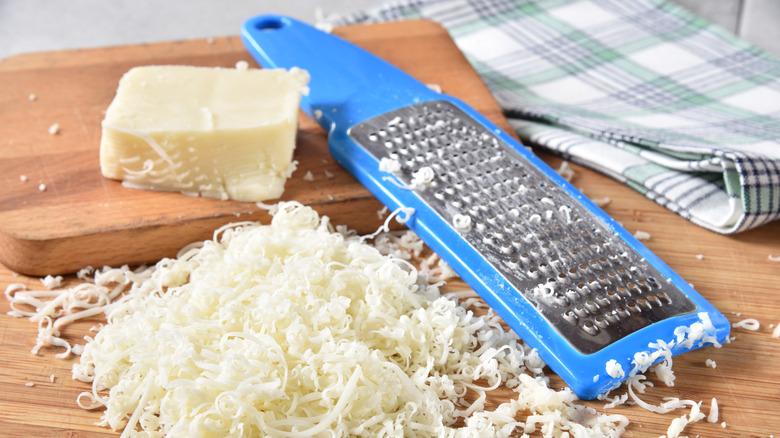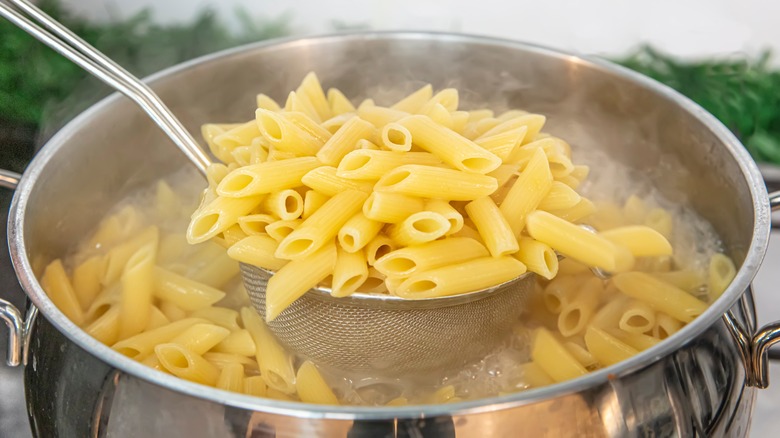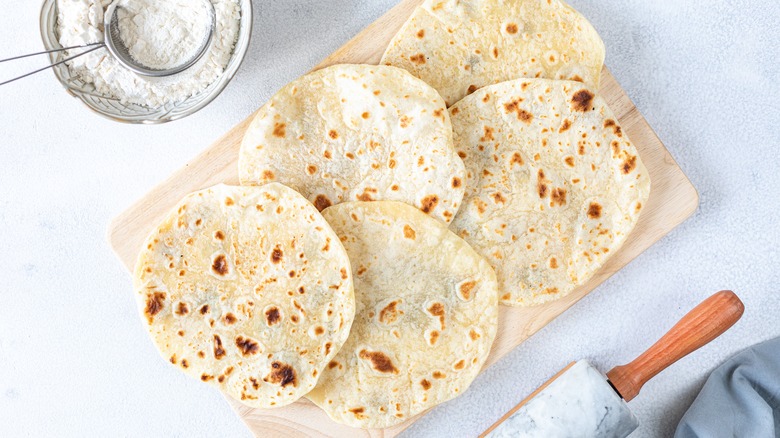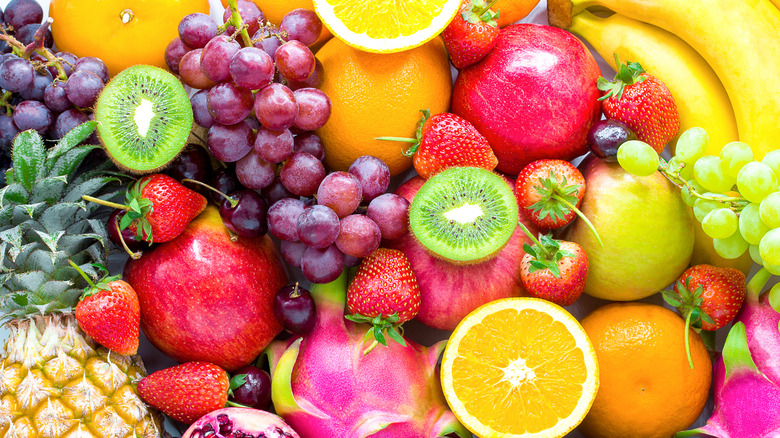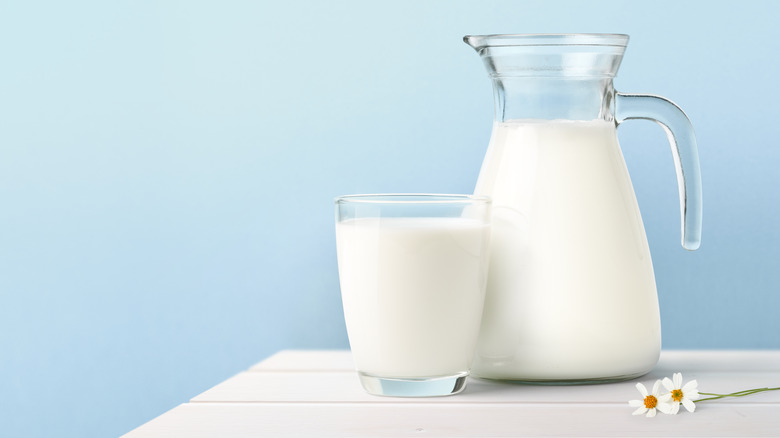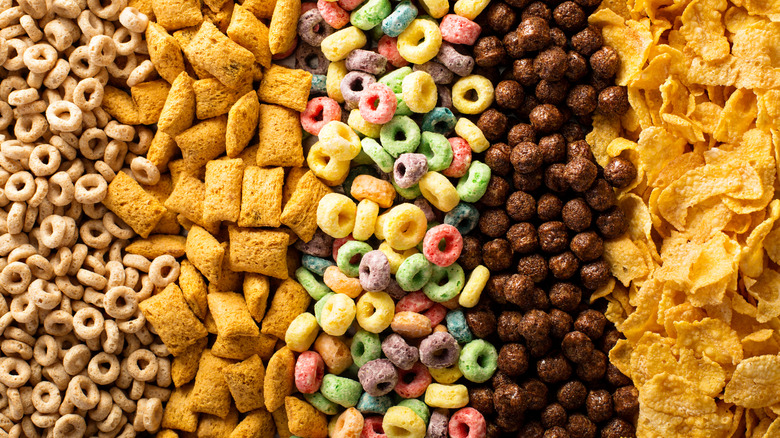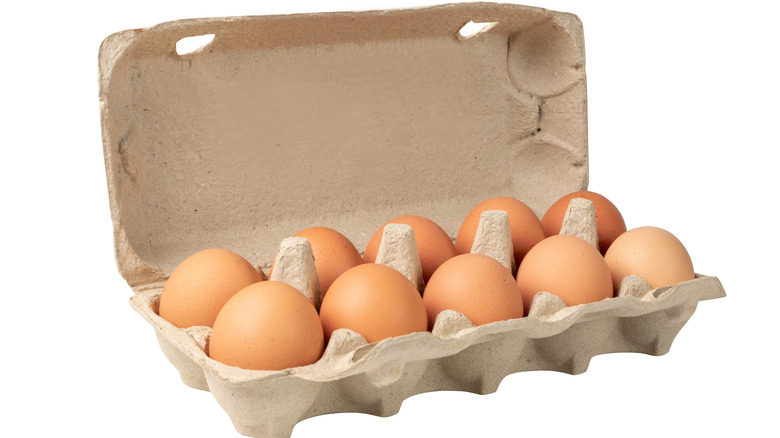13 Tricks For Using Up All Of Your Leftovers
Leftovers get an undeserved, bad reputation. They often end up sitting in the refrigerator, never being eaten, or are simply thrown in the trash. One good way to avoid food waste is to keep leftovers to eat for future meals. The act of saving portions of food instead of throwing said portions away has some truly thrifty potential. You'll save on groceries and you may save on cooking time too.
Thinking of using leftovers is one thing but actually doing it is another. So, what if you turned what seemed like lame leftovers into something new? A cup of rice, a portion of pasta, or extra meat may not seem like much, but with some innovation and additional ingredients, your leftovers can be reimagined. Read on for ways to repurpose your leftovers into new and delicious dishes.
After the meal, it's storage time
Sometimes you have leftovers because you went out to eat, other times it's because you made a bigger portion than you anticipated. But to truly savor the leftover lifestyle, it's smart to adopt the right strategies. Try doubling or tripling the size of your recipe so you know you'll have extra food to eat for the next meal, or throughout the week. Be sure to choose recipes that feature foods that are easy to reuse including ingredients like vegetables, rice, and beans.
Use clear storage containers so you'll easily be able to identify what items you have left over. Next, think outside the idea of just reheating your leftovers. See how you can use them in new recipes — consider something simple, like repurposing them in a casserole or as breakfast for dinner. Another idea is to plan a night where you have what my mother calls a strategy of, "a little bit of this and a little bit of that," such as a buffet of many small portions of leftovers.
Repurposing leftover rice
Rice is a pantry staple. Whether you have leftover rice from a restaurant meal or from a batch made at home, rice is one of the most versatile leftover ingredients available in your cupboard (or in your fridge, if you already have it cooked). Rice can have a second act in a lot of tasty dishes, including rice pilaf, fried rice, wild rice soup, sushi, stuffed bell peppers with rice, burritos, vegetarian bibimbap, and more.
There are three good ways to reheat leftover rice: in the microwave by adding a little water to the rice, mixing it with a fork, and then placing a damp paper towel over the bowl before microwaving; on the stovetop by adding a little bit of water to the rice, covering it while reheating it on low, and stirring as needed; or reheating rice in the oven by spreading it on a baking sheet, sprinkling water over the rice, and covering it with foil until it warms up.
Discover the versatility of leftover chicken
Chicken is a popular leftover protein to repurpose. Whether you have leftover chicken from a meal at a restaurant, or you prepared a lot of chicken on the grill, baked breasts in the oven, or bought a rotisserie at the grocery store, you'll have many options for next-day meals.
Buy a rotisserie chicken or two at the grocery store and shred them, each yielding three to four cups of chicken. The chicken can be used immediately, refrigerated, or frozen for future use. Use the chicken to make recipes like a Cobb salad, chicken tortellini soup, a chicken Parmesan casserole, chicken pesto pasta, chicken burrito bowls, and barbecue chicken sliders, among others. You can also use a rotisserie chicken carcass to make chicken stock too.
Be careful when reheating chicken because it can dry out fast. Using the oven to reheat chicken is your best bet. Reheat it on 350 degrees Fahrenheit, placing your chicken in a baking dish with a cup of chicken broth or water and covering it with foil. Reheat it for 15 minutes, remove the foil, and cook for five or more minutes, or as long as it takes to reach an internal temperature of 165 degrees Fahrenheit.
Get creative with leftover veggies
Vegetables are important for health, providing nutrients and antioxidants that bodies need. One of the ways you can add more veggies to your diet is by including them in soups — for example, broccoli would be a great way to add vitamins and fiber to your diet. Other suggestions include making zucchini lasagna; spiralizing extra fresh veggies into a pasta substitute; using extra cauliflower to make a pizza crust; or whipping up green smoothies featuring extra veggies from your refrigerator including leafy greens, avocado, and sweet potatoes.
Vegetables can be added to eggs too for a variety of dishes, including quiches, veggie omelets, and scrambled eggs with diced veggies. You can also make veggie quesadillas, and use veggies and beans in tacos, frittatas, pizza, vegan mac and cheese, and salads. You can also work in a lot of veggies at once by eating a delicious vegetable stir fry.
Make leftover steak the star of your next meal
Steak is another versatile protein that's the main ingredient in many leftover creations. Leftover steak can be used to make carne asada quesadillas, steak Diane, steak fajitas, cheesesteak sandwiches, Mongolian beef, fajitas, pepper steak, steak salad, stuffed peppers with steak, and more.
Be careful when reheating steak because it can overcook and dry out if you hurry the process. It's important to reheat steak on low heat. You can reheat it in the oven, in a pan, in the microwave, or in sous vide. For best results, let the steak sit out on the counter for a few minutes before reheating — not straight from the fridge, which could make it dry out during cooking. If you have a whole piece of steak left over, sear it with olive or vegetable oil to help it retain flavor. Consider adding extra flavor from onions, and seasoning too. Whatever method you use to reheat your steak, let it sit for five minutes before serving which should help it retain its juices and flavor.
Melt for these leftovers made with cheese
Whether you have a whole block of cheese or even just half a cup, you can do a lot with leftover cheese. Have a few kinds of cheeses like cheddar, Monterey Jack, and mozzarella? Mix them up to create a cheese blend that's perfect for cooking up a great grilled cheese sandwich. If you want to craft gourmet grilled cheeses, consider including bacon, tomato, or spinach. Get more adventurous with grilled cheese sandwiches featuring avocado, buffalo chicken, pizza, or turkey cranberry too.
If you have cheddar cheese, consider making a homemade nacho cheese sauce, whipping up macaroni and cheese, making a cheesy potato soup, grilling up some quesadillas, or preparing a ham and cheese quiche, as well as cheese dip, casseroles, and soups. Top scrambled eggs with cheese, or add some as a topper for your salad. Need more cheesy goodness? Check out a variety of top cheese recipes from The Daily Meal.
Leftover pasta possibilities
Cooked too much pasta? No problem! If you have leftover spaghetti, turn it into an easy-to-make hearty spaghetti casserole featuring lean ground beef, onion, tomato soup, mushroom soup, cheese, and more. The meal is ready in about 50 minutes.
Did you know you can freeze cooked pasta? All you'll need to do is start by cooking your pasta al dente so it doesn't start its journey all mushy. Drain the water in which the pasta was cooked, then add olive oil to keep the noodles from sticking together. Let the pasta cool to room temperature, place it in a freezer bag, and toss it in your freezer.
Once frozen, your pasta should stay useful for the next 3 to 6 months. To use the pasta, thaw it in your fridge overnight, then microwave for 5 minutes before serving. Use the leftover pasta in a variety of dishes including pasta salads, casseroles, soups, and slow cooker meals like chicken cacciatore.
Don't let tortillas go to waste
Leftover tortillas could be the start of a great dinner. You can make enchiladas, quesadillas, fajitas, tostadas, tacos, burrito bowls, or a hearty bowl of tortilla soup. Tortillas are also great for breakfast including Chilaquiles, or breakfast tacos. And don't forget to make homemade tortilla chips.
Corn tortillas tend to be smaller than flour tortillas and are not as sturdy. You can make many Mexican dishes like tacos or quesadillas using either corn or flour tortillas. But some foods need a larger surface area which is why burritos feature large, flour tortillas.
While flour tortillas can stay fresh in your fridge for around 10 days, you can freeze them for up to 8 months from when they were fresh. Simply place parchment paper between each tortilla and freeze them in small batches so they'll be easy to defrost when needed. Thaw them on your kitchen counter for an hour before heating them or using them in a prepared dish. The Daily Meal has a recipe for homemade tortillas that you should take a peek at, too.
Make the most of your fresh fruit
There are a lot of reasons why you might have fresh fruit left over: maybe you bought a lot during a big sale, your farm box is bursting with fruit, or your garden had a great harvest. Whatever the reason, don't let all that fruit go to waste.
If you have fruit that's going bad, like bananas and pears that are very ripe, you need to use them right away. Toss them on the grill, or chop them up for a wild bloody mary. You could use a kiwi to tenderize meat, have breakfast for dinner with bananas or berries as the star ingredients, or blend ripe fruits into a smoothie.
Use a dehydrator to make your own fruit roll-ups, or fruit chips, use a blender to mix up some fruits for ice pops, or slice up some citrus to add some zing to your water. Some fresh fruit can be frozen for later use. You can freeze a wide variety of fruits if you feel so inclined: apricots, berries, citrus, plums, and others, too.
Use up milk before it's best by date
If you have leftover milk that's just sitting in your fridge, don't let it expire without being used. Instead, you can use it to make homemade yogurt, trifle and Tres leches cake, smoothies, creamy soups, and other creamy dishes.
Use milk to make drinks including hot chocolate, eggnog, and milkshakes. It can also be used to tenderize fish, chicken, or pork. Make your milk last longer too! Place the milk on a shelf deep inside your refrigerator, rather than in the door where temperatures are not consistent because the fridge door is opened and closed often.
Want to freeze milk for future use? You can freeze it right in its container. First, pour out an inch's worth of milk so that the container can expand when it's frozen, replace the cap, and freeze your container of milk. When you want to use the milk, defrost it a day before you need it, by placing it in the refrigerator. Never let it thaw on the counter which can cause bacteria to grow. Be sure to shake it thoroughly so the water and fat, which separate when frozen, mix again.
Give stale bread a second chance
Unless it's gone bad — you know, green with moldy spots — you don't have to throw out leftover bread. Instead, find new ways to use it. Use any kind of leftover bread to make croutons, or you can put the stale bread in your food processor to grind it into breadcrumbs. Nearly stale bread can also be used to make French toast, bread pudding, an Italian Strada (which is like a casserole), a bread topper for your French onion soup, bruschetta, or a breakfast casserole. If you have hearty bread like sourdough or ciabatta, make a Panzanella salad.
Old bread could have a second life if you freeze it. It's best to freeze bread when it's still fresh, but older bread can be frozen as well. The only downside? After defrosting, stale bread has a short window for use. If you want to freeze bread, keep it in its original packaging, squeeze out the extra air, and place it in a plastic freezer bag. Bread will lose its moisture when defrosting and notes bread will only last about three months in the freezer.
Think twice before you throw out spare coffee
Coffee lovers rejoice — you don't have to throw out leftover coffee. Whether you made too much java for a party, or just have extra beans in your pantry ready for grinding and brewing, you have a lot of options for surplus coffee.
Make coffee ice cubes that can be used to keep your cold brew extra cold, or for cooling down hot coffee without diluting it. You could briefly store leftover coffee in your fridge and use it for iced coffee later but note that it'll get stale in a few hours unless it's consumed. Other uses include making your own ice cream, adding coffee to your oatmeal for a boost of caffeine, or marinating meat, fish, or chicken in coffee.
Coffee is the secret ingredient in a lot of recipes, including in sweet treats like brownies, muffins, and smoothies, and in savory dishes like chili, mole, and soup (via Mashed).
Turn leftover cereal into a tasty snack or treat
If you're overwhelmed by the amount of cereal in your cabinet, don't worry. Whether you stocked up too much when cereal was on sale, or you just have a leftover cup or two of different kinds of cereal, you can re-purpose those cereals into something appetizing.
Keep things simple by adding a cup of crunchy cereal to yogurt, oatmeal, and bananas. Or get more creative by mixing a bunch of your favorite cereals into a bag or bowl to make a trail mix featuring rice cereal, corn puffs, and cereal squares with other pantry staples like raisins, peanuts, and chocolate candies. For colorful and kid-friendly cereal treats, consider using honeycomb cereal to make a sweeter version of Rice Krispie treats, using Fruity Pebbles to make breakfast bread, or adding Froot Loops as a topper for cinnamon rolls — sweet and salty is the way to go.
Egg-cellent options for extra eggs
Have too many eggs? Whether you have a few extra or a dozen or more, you have a lot of options. If you have a few eggs, make the basics like scrambled eggs, frittatas, bread, pancakes, crêpes or French toast. Consider poaching eggs, frying them, or soft boiling them too. But if you have even more eggs that you want to use, consider making dishes which call for more eggs, including egg salad, egg drop soup, or deviled eggs. Eggs can be the star ingredient in a variety of desserts too including eggnog, crème brûlée, custard cups, lemon meringue pie, or flan.
If you still have too many eggs, you can consider freezing them. It's important to note that you can't whole eggs in their shell since they will break during the process. Start with fresh eggs and crack them — yolks and whites — into a freezer safe container, where you can gently stir them. Freeze one to two cups of eggs at a time. Label your container and use the eggs within six months. Thaw in the refrigerator before use.
